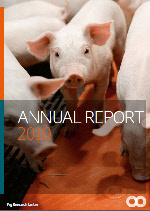



Danish Pig Research Centre: Annual Report 2010: Development of Environmental Technologies
The 2010 annual report from the Danish Pig Research Centre outlines the development of environmental technologies at Grønhøj.
New Trial Facilities
At Experimental Station Grønhøj, Pig Research Centre (PRC) has designed four facilities for development and testing of new technologies before these are studied on commercial pig farms. The projects concern:
- Feeding
- Pit ventilation
- Handling and treatment of slurry
- Air cleaning
Feeding
Several of the most dominant odour compounds emitted from slurry contain sulphur. PRC therefore investigated the effect of reducing sulphur in pig feed to reduce the concentration of sulphur in slurry.
In one trial group, the sulphur concentration was minimised, whereas in the other, it was minimised and also fibre was added to the feed. Increased fibre content in pig feed supposedly increases the microbial activity in the large intestine and in slurry, and consequently potential odorants are incorporated into the biomass.
The control feed was a traditional finisher diet. The investigation ran for two growth periods. The results from the first period revealed a moderate reduction in odour emissions that was not statistically significant, whereas the results from the other period revealed significant reductions. The investigation did not clearly demonstrate the effect of reducing sulphur in pig feed, and this is therefore still being investigated.
The investigation was made in co-operation with Aarhus University and was financially supported by the Danish Ministry of Food, Agriculture and Fisheries under Action Plan for the Aquatic Environment Three.
On behalf of the Austrian company, Delacon, the effect of their product Fresta® F Plus on ammonia emission was studied. Delacon had previously found a positive effect on ammonia concentrations when the product was added to feed. However, no effect was found on ammonia emissions at the trial facilities at Grønhøj.
Pit Ventilation

| Extract of results of recordings of ammonia and odour at a desired air output of 10 cubic m etres per pig and per hour with pit ventilation | ||||||
| Gruppe | 1. Partially solid floor | 2. Drained floor | 3. Specially drained, ventilation dunging area | 4. Specially drained, ventilation lying area | ||
|---|---|---|---|---|---|---|
| Exhaust | Ceiling | Ceiling | Pit | Ceiling | Pit | Ceiling |
| Air output, m3/hr/pig | 57 | 52 | 10 | 49 | 10 | 48 |
| Odour conc., OUE/m3 | 290 | 480 | 890 | 170 | 1230 | 200 |
| Odour emission, OUE/s per 1000 kg | 66 | 99 | 31 | 33 | 47 | 38 |
In a series of investigations, pit ventilation, different types of flooring and different positions of suction points were studied with the aim of developing pit ventilation for fully drained finisher pens. This will drastically improve the working environment and reduce costs related to air cleaning.
The results demonstrated that it is possible to collect the majority of ammonia, odour and hydrogen sulphide in a small part of the total ventilation capacity. A certain flow of air through the slatted floor is important to the efficiency of pit ventilation. Furthermore, placing the suction points below the pigs’ lying areas instead of under the dunging area also markedly increased the efficiency.
In 2010, full-scale pit ventilation will be investigated.
SmellFighter
In the summer 2009, a project financially supported by the Danish Food Industry Agency under the Innovation Act and with participation of BioAqua A/S, Infarm A/S and PRC was made on optimising the process of treating slurry with ozone and acid (the SmellFIGHTER).
Once a week, slurry was emptied from the pig house to a treatment facility where it was mechanically separated. The thin fraction was treated with ozone and acidified with sulphuric acid to pH5.5 before it was returned to the slurry pits of the pig house. Between the weekly emptying, it was necessary to separate and acidify the slurry once more to improve the effect on ammonia emissions.
For two production batches in the period April to August 2009, a 40 per cent reduction in odour and ammonia emissions was recorded from the climate chambers with slurry treatment, in comparison to the climate chambers in which the slurry pits were emptied approximately every six weeks.
In 2010, the process was optimised further to enhance the effect on ammonia and, consequently, slurry is now acidified six days a week and treated for odour during separation and ozonation once a week.
In the summer 2010, Pig Research Centre initiated an investigation of a full-scale SmellFIGHTER on a finisher farm.
CEBONA

Pig Research Centre is participating in a joint venture on development of cost-efficient biofilters for the reduction of odour from pig houses. The project includes detailed investigations of the way the physical characteristics of different filter materials affect chemical and biological processes and mechanisms essential to the elimination of sparingly soluble odorants. The aim is to improve the design of biofilters for livestock houses with emphasis on maximum elimination of pollutants and minimum energy for operation.
The project, which is supported by The Danish Council for Strategic Research, began in January 2009 and will run for four years. Aarhus University, Aalborg University, SKOV A/S and Saint-Gobain Weber were also involved in the project. The project is simply called CEBONA, which is an abbreviation of Cost-Effective Biofilter for Odour Nuisance Abatement for Intensive pig production.
LECA as Filter Material
Together with Saint-Gobain Weber, PRC is studying the use LECA® as filter material in biological air cleaners. The project is financially supported by the Ministry of Food, Agriculture and Fisheries under the Innovation Act.
The aim is to develop a LECA filter module for biological air cleaning that reduces odour and ammonia emissions from pig houses with a minimum consumption of energy. Previous full-scale studies showed that LECA is an efficient medium for air cleaning, but also that the potential of LECA as filter material is highly dependent on an optimum filter design.

At Experimental Station Grønhøj, two air-cleaning modules are installed with LECA® as filter material in a finisher section where odour and ammonia reductions will be recorded in 2011. The project will be completed by the beginning of 2012.
Further Reading
| |
- | Go to our previous article on this report by clicking here. |
October 2011








